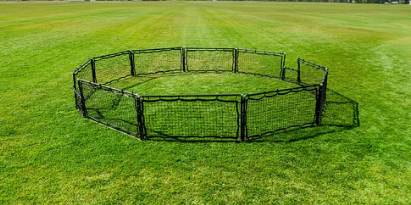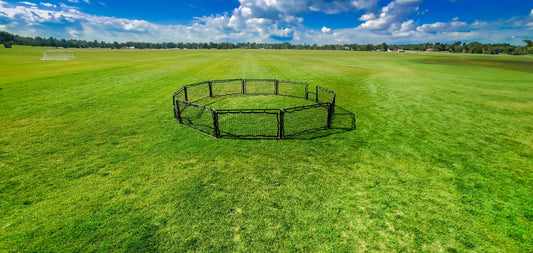Playing games outside offers a plethora of benefits for individuals of all ages. Whether it's children engaging in imaginative play, teenagers participating in team sports, or adults enjoying recreational activities, playing games outdoors has a positive impact on physical, mental, and social well-being.
Firstly, playing games outside promotes physical activity and fitness. Outdoor games often involve running, jumping, throwing, and other physical movements that contribute to cardiovascular endurance, muscular strength, and overall physical health. Active play outdoors helps combat sedentary lifestyles and encourages children and adults alike to engage in regular exercise. It improves motor skills, coordination, balance, and agility while fostering a love for physical activity that can be carried into adulthood.

Additionally, playing games outside enhances cognitive development. Outdoor play stimulates the senses and provides opportunities for exploration, problem-solving, and creativity. Natural environments offer new stimuli and challenges, promoting imaginative play and fostering cognitive skills such as critical thinking, decision-making, and spatial awareness. Interacting with the natural world can also foster an appreciation for nature, environmental consciousness, and a sense of curiosity about the world around us.
Outdoor games have a positive impact on mental health and well-being. Spending time outside in natural settings has been shown to reduce stress, anxiety, and depression. Exposure to sunlight aids in the production of vitamin D, which plays a role in mental health and mood regulation. Being in nature has a calming effect, promoting relaxation, mindfulness, and improved mental clarity. Playing games outdoors also provides a break from technology and screens, allowing individuals to disconnect, rejuvenate, and recharge.
Playing games outside facilitates social interaction and the development of social skills. Whether it's team sports or cooperative games, outdoor play encourages communication, cooperation, teamwork, and sportsmanship. It provides opportunities for individuals to engage with others, build relationships, and practice social skills such as sharing, taking turns, and resolving conflicts. Outdoor games foster a sense of belonging, camaraderie, and community as people come together to participate in shared activities.
Moreover, playing games outside promotes healthy competition and resilience. Outdoor games often involve rules, challenges, and goals, creating opportunities for individuals to set objectives, work towards them, and learn from both successes and failures. Participating in outdoor games instills qualities such as perseverance, determination, and adaptability. It teaches individuals to handle both victories and defeats graciously, fostering resilience, self-confidence, and a positive attitude towards challenges.
Outdoor play also offers an escape from routine and the chance to connect with the natural world. It allows individuals to enjoy fresh air, sunshine, and the beauty of the surrounding environment. Being outdoors promotes a sense of freedom, exploration, and adventure, stimulating curiosity and a sense of wonder.
To go along with the phrase, “Go big or go home” here is a list of games that can be played with large groups of people.
Kickball - Kickball is a recreational team sport that combines elements of baseball and soccer. It is a popular game played primarily in informal settings, such as schoolyards, parks, and community leagues. Kickball is enjoyed by people of all ages and skill levels, making it a versatile and inclusive activity. The objective of kickball is similar to baseball: to score runs by rounding bases and reaching home plate while the opposing team tries to tag or throw out the runners. However, unlike baseball, kickball uses a large inflated rubber ball, similar to a soccer ball, which is rolled or kicked by the offense instead of being hit with a bat. The game is typically played on a field with bases set in a diamond shape, similar to a baseball or softball diamond. The pitching area is called the pitcher's mound, and the home plate is where the kicker stands to kick the ball. The defense consists of fielders positioned in various positions, including pitchers, catchers, infielders, and outfielders. The game begins with a player from the kicking team, known as the kicker, attempting to kick the ball after it is rolled by a member of the opposing team. The goal is to kick the ball and safely reach one of the bases without being tagged or thrown out. Runners can advance to subsequent bases when the ball is kicked successfully, similar to how runners advance in baseball. The defense's objective is to catch the kicked ball in the air or on the ground and quickly throw it to a teammate to tag a runner or touch a base to record an out. The defense can also get outs by catching a fly ball before it hits the ground or by tagging a base before a runner reaches it. The offense continues to kick and run until they have accumulated three outs, just like in baseball.
Ultimate Frisbee - Ultimate Frisbee, often referred to as just "Ultimate," is a fast-paced team sport played with a flying disc (Frisbee). It combines elements of football, soccer, and basketball, creating a unique and exciting game that is enjoyed by people of all ages and skill levels. The objective of Ultimate Frisbee is to score points by passing the disc to teammates and completing successful throws into the opposing team's end zone. Players move the disc by throwing it to their teammates and are not allowed to take steps while holding the disc, similar to basketball rules. Ultimate is played on a field with two end zones, similar to American football. Teams typically consist of seven players on each side, but the number of players can vary depending on the level of play and available space. The game begins with a "pull," where one team throws the disc to the opposing team to initiate play. The disc is advanced through a series of throws and catches among teammates. Players must pass the disc within a set number of seconds and cannot run with it. They can move freely around the field, utilizing their speed, agility, and throwing skills to create opportunities for their team. The objective is to complete passes and work together to advance the disc into the end zone for a score.

9 Square - 9 Square is an outdoor game that is played with a large inflatable or metal frame that is divided into nine smaller squares. Each player stands in their own square, and the objective of the game is to eliminate players from other squares by bouncing a ball into their square. The rules are, Set up the frame and divide into nine squares, with each player standing in their own square. The player in the center square starts the game by bouncing the ball into one of the other squares. The player in that square must hit the ball into another square, and so on. If a player fails to hit the ball into another square, they are eliminated and must leave the game.Variations of the game include adding rules such as no holding the ball or no hitting the ball with the same hand twice in a row.
Volleyball - Volleyball is a popular team sport played on a court between two teams. The objective of the game is to score points by successfully hitting a ball over a net and into the opponent's court while preventing the opposing team from returning the ball. It is a fast-paced and dynamic sport that requires skill, coordination, and teamwork. Volleyball is typically played with six players on each side, although there are variations of the game with different numbers of players. The court is divided into two halves by a net, and each team is positioned on their side of the court. The game begins with a serve, where a player from one team hits the ball over the net to the opposing team. The receiving team must then return the ball within three touches, typically using a combination of passes, sets, and spikes. The objective is to make the ball land in the opponent's court and to prevent the opposing team from successfully returning it. Teams can score points in various ways. If the ball touches the ground within the opponent's court, the serving team scores a point. If the serving team commits a fault, such as serving the ball out of bounds or hitting the net, the opposing team earns a point and the right to serve. Points are also awarded if the receiving team fails to return the ball properly or commits a violation.

Dodgeball - Dodgeball is a fast-paced and energetic game played with two teams. The objective of dodgeball is to eliminate players from the opposing team by hitting them with thrown balls while avoiding being hit yourself. It is a popular sport often played in physical education classes, recreational settings, and even organized leagues and tournaments. The game is played on a rectangular court, typically indoors or outdoors, with a center dividing line and boundary lines marking the team areas. Each team consists of players who start the game on their respective sides of the court. The playing area is usually divided into three sections: two team zones and a neutral zone in the center. The game begins with the referee or an agreed-upon signal releasing several balls placed in the center of the court. Players from both teams rush towards the balls, aiming to retrieve and throw them at members of the opposing team. The primary objective is to hit an opponent with a thrown ball, causing them to be eliminated from the game. If a player is hit by a ball thrown by the opposing team and the ball touches any part of their body, they are considered "out" and must leave the playing area. However, if a thrown ball is caught by a member of the defending team without it touching the ground or any other object, the thrower is eliminated, and the catching team can bring one of their eliminated players back into the game. Dodgeball combines elements of skill, strategy, and agility. Players must have quick reflexes to dodge incoming balls while also aiming accurately to hit opponents. Strategies often involve teamwork, communication, and coordination to trap opponents or create openings for successful throws. The game continues until one team has eliminated all the players from the opposing team. Alternatively, a time limit can be set, and the team with the most players remaining at the end of the time period wins. A fun variant of dodgeball is Gaga Ball.
Capture the Flag - Capture the Flag is a popular outdoor team game that combines elements of strategy, teamwork, and physical activity. The objective of the game is for each team to capture the opponent's flag and bring it safely back to their own territory while defending their own flag from being captured. The game is typically played on a large playing area, such as a field or a designated outdoor space. The playing area is divided into two halves, each belonging to one of the opposing teams. Each team has a flag, which is usually placed in a designated "home base" or "flag station" in their territory. The game begins with each team guarding their own flag while also attempting to capture the opponent's flag. Players move around the playing area, using strategies to outwit the opposing team and retrieve their flag. To capture the flag, a player must successfully reach the opponent's territory, grab the flag, and safely return it to their own territory without being tagged by the opposing team. If a player is tagged by an opponent while in the opponent's territory, they are typically "captured" and must go to a designated "jail" area. They can often be freed if a teammate successfully reaches the jail area without being tagged and tags them. Some variations of the game allow captured players to be freed by touching a specific designated area in their own territory. Capture the Flag encourages teamwork, communication, and strategic thinking. Players must coordinate their movements, plan attacks and defenses, and communicate with their teammates to execute successful flag captures and protect their own flag. The game fosters problem-solving skills and promotes cooperation and collaboration among team members.
In conclusion, playing outside offers numerous benefits for individuals of all ages. Engaging in outdoor activities promotes physical fitness, as it encourages movement, exercise, and the development of gross motor skills. It provides an opportunity to soak up vitamin D from sunlight, contributing to overall health and well-being. Outdoor play also enhances cognitive development, creativity, and problem-solving skills, as individuals interact with their surroundings, navigate obstacles, and engage in imaginative play. Moreover, playing outside fosters social interaction, cooperation, and communication among peers, promoting the development of social skills and the building of relationships. It offers a break from technology and screens, allowing individuals to connect with nature, reduce stress levels, and improve mental well-being.







